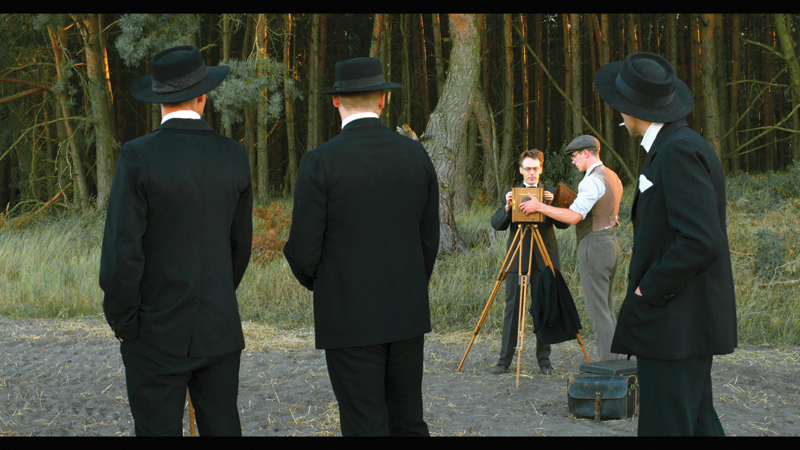« Reviews
New Pictures: Omer Fast, Appendix
Minneapolis Institute of Art - Minneapolis, MN
Curated by Yasufumi Nakamuri
By Christina Schmid
“Appendix,” a three-part exhibition at the Minneapolis Institute of Art curated by Yasufumi Nakamuri, sets two recent films by Omer Fast, Looking Pretty for God (2008) and August (2016), in dialogue with August Sander’s century-old photographs of German people: farmers, construction workers, artists, bricklayers, and revolutionaries gaze at the camera with stern, unflinching eyes. Carefully posed, each of Sander’s subjects is fully aware of the photographer’s presence and the making of the image. August imagines the artist as an old man haunted by his past, while Looking Pretty for God combines a funeral director’s dispassionate explanations of his profession with images of a faux children’s fashion shoot. What emerges from the dialogue between still and moving images is an intricate reflection on time, memory, mortality, and the role and reliability of images and their makers.
Carefully sequenced, the exhibition begins in a non-descript waiting room: chairs line the walls, a water cooler, coat rack, and potted plastic plants complete the ambience. A couch faces a low table littered with magazines. While you wait in such carefully designed, inoffensive neutrality, Looking Pretty for God loops on a wall-mounted flat screen. The voiceover alternates between the details of preparing a body for an open-casket funeral-you replace a third of the body’s blood with embalming fluid, fluff cheeks with cotton wads and clean dirty fingernails-and the psychology of grief, especially how people want to visually remember deceased loved ones. The images alternate between children getting readied for the fashion shoot and empty coffins, luxuriously lined in shiny fabrics. At times, when the young models lip-sync the funeral director’s stories, the discrepancy between speaker and spoken turns creepy, emphasizing further the artificiality and unreliability of what you see.

Omer Fast, August (film still), 2016, stereoscopic film in 3D, 5.1 surround sound, 15:30 minutes. The Christina N. and Swan J. Turnblad Memorial Fund. Courtesy of the artist and gb agency, Arratia Beer and Dvir Gallery and James Cohan Gallery. © Omer Fast, 2016.
August screens in the next gallery. Blind, the famed photographer follows strings that run through his apartment, orienting him from bed to bathroom to gramophone. Thanks to 3-D, they seem to extend off the screen as if to compromise the separation between surface and space. The passage of time, too, is compromised as Sander’s memories invade his present. One memory in a particular, an encounter with a uniformed Nazi officer, is of central importance to the film and the exhibition as a whole. While completing the death certificate for Sander’s son, who died in prison of a burst appendix, the bureaucrat compliments the tender empiricism of Sanders’ work, poses for a portrait, and muses on the appendix: it only lives off the system like a parasite. But infected, it can endanger an entire organism. The innuendo connecting the artist-as-appendix to the social body is unsubtle.
People of the Twentieth Century, Sander’s ambitious collective portrait, restates the question of social purpose. His titles identify his subjects, with the notable exception of artists, their assistants, and wives, by their profession and social role. Some are portrayed with tools of their trade; others in their finery. The photographs conjure a Germany before World War II, when social destinations equaled identity. Yet his images, no less than the fictitious photographer’s in Looking Pretty for God, construct his subjects. The dialogue between Fast’s films and the century-old silver gelatin prints amplifies the ideology driving the production and consumption of images, then and now. The parallels are disconcerting; the myth of neutrality thoroughly exhausted. The image performs as future memory, its questionable reliability imperfectly masked by nostalgia for a lost specter of authenticity.
(September 23, 2017 - February 11, 2018)
Christina Schmid is a writer, critic, teacher and curator. She works at the University of Minnesota’s Department of Art, where she teaches contemporary practices and critical theories. Her essays and reviews have been published both online and in print, in anthologies, journals and digital platforms, including Artforum, Flash Art, Foam Magazine, afterimage and mnartists.com.
Filed Under: Reviews



































Leave a Reply
You must be logged in to post a comment.